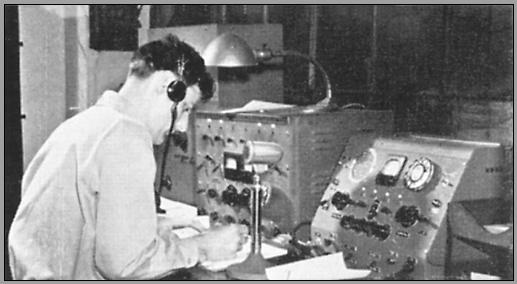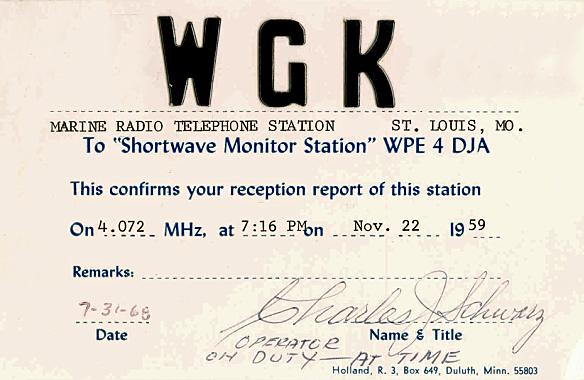
WGK - St. Louis

John Frank at the WGK Operating Position in 1951 --- From RCA Advertisement
Why was WGK, which was west of the FCC's Mississippi call letter dividing line, not KGK? Perhaps because it started life east of the Mississippi. The 1935 FCC Annual Report contains the following statement: "The coastal telegraph station formerly located near Cincinnati Ohio, has been moved to St. Louis, MO., in order to serve more efficiently ships navigating the Mississippi, Missouri, and Ohio Rivers." It is very likely that this station was RMCA's WGK, putting it on the air in St. Louis in 1935, and making it the first station serving towboats.
Though some is known about the Army Corps of Engineers early CW use on the rivers see: Government Stations CW use by WGK raises many unanswered questions about the history of CW for commercial communications on the rivers: When did the towboats start usingCW? Were there Radio Officers on the towboats or, unlikely, were the captains and/or pilots also trained as CW operators? Most of this history is probably lost.
The 1942 FCC Annual Report says: " --- the commission licensed a new coastal harbor station at St. Louis, Mo ---." This was the beginning of WGK's radiotelephone service. However, this RMCA 1946 document indicates that WGK still had CW capability at that time.
In the 1940s the station was located at the foot of Rutger Street in St. Louis on the 2nd floor of the Mississippi Valley Barge Line terminal. There was an excellent panoramic view of the Mississippi from the operations room. Although MVBL was probably the largest WGK customer there were many others notably Federal Barge Lines.
There
were two identical operating positions at the station. In the photo
above, the unit with the sloping front panel was the main controller
for the station. The telephone dial on the upper right, was the dial
for the two-tone ringer system that was sometimes used to selectively
call a boat .
The main transmitter was made by Wilcox, and is identical to the one shown in the photos of sister RMCA station WCM - Pittsburgh. It had four large roll out bays, one for each frequency. In each bay the power was 2KW and used four Eimac 450TL tubes in push-pull. The AM modulator consisted of two 450TL's. All four antennas at the station were half-wave dipoles and all were fed by open wire feeders spaced 6 inches apart. They were supported on telephone poles about 60 feet high.
Here is a RMCA Advertisement which appeared in the now defunct Waterways Magazine in November 1951. It shows RMCA Ship-to-Shore radiotelephone services for towboats on the Mississippi River system. Here's a 1946 RCA Calendar advertising both CW and radiotelephone service at WGK. However, Bill Hutchinson reports that by the time he arrived at the station in 1947 CW was all but dead.
William Hutchinson, W7EX, an operator at WGK from 1947 to 1952, supplied some of the information above. Bill's Recollection Page contains interesting additional material.
By the time Ray Gartman
bought WGK from RMCA in 1967 (and also WCM for $90,000 total) it was
located in Granite City, IL on the Chain of Rocks
Canal, on Levee Road, the eastern side of the levee, about a mile north
of the interstate 270 bridge. No trace of the building or
tower and antenna array show up on current satellite imagery.
Ray's son Mark worked at the station during the 1968-69
summers and his Recollections Page chronicles the Gartman ownership of
three of the rivers stations: WGK, WCM and WJG.
Charlie Soroka, who had been doing electronic maintenance on the boats, eventually bought WGK from Gartman. He was the station's last owner.

Card courtesy of Jeff Yates
Some of the WGK crew and their recollections.
